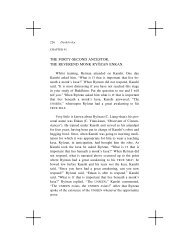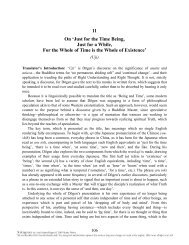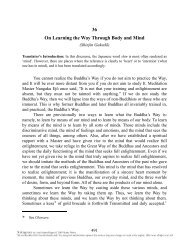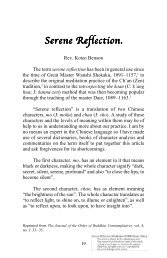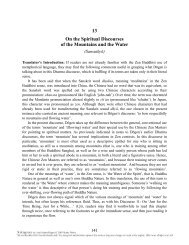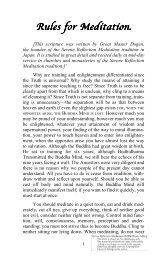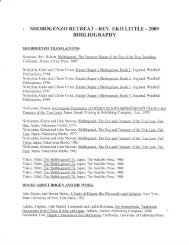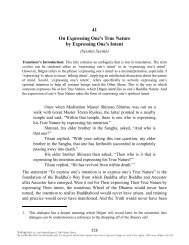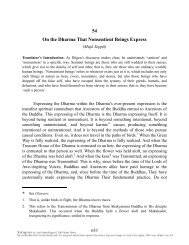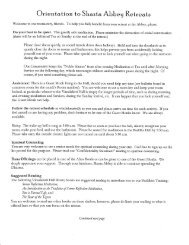The Ten Precepts Retreat - Shasta Abbey
The Ten Precepts Retreat - Shasta Abbey
The Ten Precepts Retreat - Shasta Abbey
Create successful ePaper yourself
Turn your PDF publications into a flip-book with our unique Google optimized e-Paper software.
<strong>The</strong> <strong>Ten</strong> <strong>Precepts</strong> Meeting:<strong>The</strong> Ceremony of Daily Life.Rev. Eko Little[Held annually, the week-long <strong>Ten</strong> <strong>Precepts</strong> Meetingretreat is designed for those trainees who wish to take refugein the Three Treasures and commit themselves to keepingthe rest of the <strong>Precepts</strong> as well, thereby becoming layBuddhists.]Welcome to those of you who are here for the first time;it is very nice to see you. To those who are coming back tobe here again, it is wonderful to see you. I love to see peoplecome at this time of year because I have never forgotten myfirst <strong>Ten</strong> <strong>Precepts</strong> Meeting. I hope that, if this is your first,you will look back on it as one of the more joyous occasionsin your life; hopefully, one of the most joyous.Because some of you are doing this for the first time, Iwant to explain the ceremonies in a little bit of detail andbecause some of you have done this many times before, Iwould also like to talk about what the <strong>Ten</strong> <strong>Precepts</strong> Meetingmeans, about the aspects of training that arise as a result ofdoing these ceremonies.What does it mean to take part in the <strong>Ten</strong> <strong>Precepts</strong>Meeting? What does it mean to be a Buddhist? To me,implicit in being a Buddhist is the idea of searching forsomething: one’s life has been found to be incompletesomehow and no matter what one does, no matter what sortof job one has or friends one has, there is this feeling thatsomething is still missing. Perhaps, if you have had a certainamount of experience in Buddhist training, you can say thatwhat you search for is the Lord of the House or the CosmicThis is an edited transcript of an informal talk given by Rev. Eko Little at thebeginning of the <strong>Ten</strong> <strong>Precepts</strong> retreat held at <strong>Shasta</strong> <strong>Abbey</strong> in 1983. It is reprinted,with changes, from <strong>The</strong> Journal of <strong>Shasta</strong> <strong>Abbey</strong>, vol. XIV, no. 2: 2 –14.88
<strong>The</strong> <strong>Ten</strong> <strong>Precepts</strong> Meeting: <strong>The</strong> Ceremony of Daily Life. 89Buddha. I remember that when I came to Buddhism,however, it was not that clear to me, and for many of us itmay be difficult to say that we know what it is we aresearching for because what we are looking for is beyond thebounds of our ordinary mind or ordinary level of consciousness.So there is nothing wrong with your being hereand not knowing what it is that you are looking for. <strong>The</strong> mostimportant thing is that you are looking and that you want tofind it.Because nothing in the world has been able to satisfythe longing of our hearts, we begin to look inside ourselves.This is the beginning of the Buddha seeking for the Buddha;it is what brings us to the <strong>Ten</strong> <strong>Precepts</strong> Meeting and whateventually leads us to the night of recognition. It is theBuddha seeking for Itself, the Buddha longing for Itself and,eventually, finding Itself, which is what we call the realizationof one’s Buddha Nature. Everyone has Buddha Nature;everyone possesses It. But to really bring It forth, to make Itshine and to make It a reality, one has to train. One has to useone’s willingness to cultivate this desire and this longing inorder that it may change from a little belief or a doubt thatmakes you question what you are doing to a reality that fillsyour whole life. <strong>The</strong> more you train, the more it happens.<strong>The</strong> ceremonies for the Opening of the Gate of the <strong>Ten</strong><strong>Precepts</strong> show you what you can do in your Buddhist trainingevery day of your life. It is said that in religious trainingthere are cooler and warmer moments. <strong>The</strong>re are times whenthings are really happening, when it is extremely rough andall you can do is hold on. <strong>The</strong>se times may be a bit easier todeal with than the times when nothing seems to be happeningand everything is arid or empty: every day you seem tobe just going along and nothing is happening, nothing ismoving. <strong>The</strong>se ceremonies show you how to deepen yourtraining no matter what state of mind and body you happento be in. <strong>The</strong> week of the <strong>Ten</strong> <strong>Precepts</strong> Meeting is somewhatdramatic, but what you should be able to find during it andwhat you should be able to carry back with you into your
90 <strong>The</strong> <strong>Ten</strong> <strong>Precepts</strong> Meeting: <strong>The</strong> Ceremony of Daily Life.daily life is an understanding that the <strong>Ten</strong> <strong>Precepts</strong> Meetingcan be every day for you. <strong>The</strong> ceremonies will not be ofgreat use unless you can find something that you can applyto your everyday life, to your everyday training.It is interesting to note that, with the exception of theCeremony of Following Where the <strong>Precepts</strong>, as the Blood ofthe Buddhas, Lead, almost all the ceremonies take place atnight. Whether this is by accident or design (probably a littlebit of both), it is interesting to note that they take place indarkness. Darkness should be home to a Buddhist traineebecause, to some degree or another, one’s life is filled withdarkness. <strong>The</strong>re is nothing wrong with that, as we shall see;but in each of these ceremonies, you will find that you movefrom darkness into light and go back out into darkness again.<strong>The</strong> first ceremony that we will be doing is theCeremony of the Reading of the <strong>Ten</strong> <strong>Precepts</strong>. <strong>The</strong> Japaneseword for this, Kyojukaimon, is translated as “giving andreceiving the teaching of the <strong>Precepts</strong>.” It is interesting thatthe Japanese characters not only mean accepting the<strong>Precepts</strong>, but also giving them for, when we practice the<strong>Precepts</strong> we also give them to others. I shall explain thismore fully later on.You can make a commitment to keep the <strong>Precepts</strong> for aday, for a week, for a month, for a year—for your whole life.In practice, however, you can only ever take them for now.<strong>The</strong>ir meaning will change and will grow as your trainingdeepens and at each moment you will have to want to takethem. <strong>The</strong> next time you are in the ceremony hall and youhave a few moments, go into the Achalanatha shrine whichis on the left-hand side of the main altar. Achalanatha is oneof the Kings of Light and he stands in the middle of flamesof fire holding a lariat and a sword. He uses the lariat to grabdemons and tie them up, and he uses the sword to cutthrough delusion. I often think of the rope as the <strong>Precepts</strong>with which, in the beginning, we bind ourselves up. We tieourselves up with them and we do so willingly. With the
<strong>The</strong> <strong>Ten</strong> <strong>Precepts</strong> Meeting: <strong>The</strong> Ceremony of Daily Life. 91sword, we cut through delusion. A good word for delusion isalso confusion. <strong>The</strong>refore, Achalanatha stands in the middleof fire holding the sword and the lariat as if to say, “If youwish to take the <strong>Precepts</strong>, if you wish to tie yourself up withthem, if you wish to accept the difficulty of trying to followthem in daily life, here they are for you!”<strong>The</strong> <strong>Precepts</strong> start with natural morality: we all knowthe consequences of killing, stealing, lying, etc. But as ourtraining deepens, the <strong>Precepts</strong> begin to take on a deepersignificance. I have heard Rev. Master Jiyu-Kennett explainthat the <strong>Precepts</strong> help you to see the whole of the CosmicBuddha. That is their purpose. <strong>The</strong>y are not there to get inyour way; they are there to help you. <strong>The</strong>y are like the guardrailson the freeway: there are six lanes to move in but youdon’t go past the guardrail over here, and you don’t go pastthe guardrail over there, and all along the way, they help youget to where you are going. In the kaimon of Kyojukaimon,the character for kai means “precept” and mon means “gate.”Truly, accepting the <strong>Precepts</strong> is the gateway into theBuddhist Way.Achalanatha stands in the midst of flames, i.e.,Achalanatha stands in the midst of hell. It is good to knowthat hell in a Judeo-Christian context means something alittle different from the hell the Buddhist is talking about.<strong>The</strong> Buddhist term for hell in this context is samsara, theconstantly turning wheel of birth and death. Achalanathastands amid the flames of suffering, which are part ofphysical existence. He is also called the Great Immobile Oneand this explains the ferocity of his image. He is theBodhisattva of awareness, steadfastness and immobility.He is just going to sit there; he is going to take the <strong>Precepts</strong>;he is going to cut through confusion and there are no twoways about it. So Achalanatha is a very good expression ofwhat arises naturally when you meditate. Everyone likesAvalokiteshwara because Avalokiteshwara looks like such agentle lady, but it is important to look at some of the other
92 <strong>The</strong> <strong>Ten</strong> <strong>Precepts</strong> Meeting: <strong>The</strong> Ceremony of Daily Life.Bodhisattvas too and see what they are trying to teach. Youdo have to be a bit fierce, in a positive sense, in order to trainproperly; you have to have courage. Courage is anotherword for will; and the only thing that stops the will is fear—“the only thing to fear is fear itself.” Once you become reallyfamiliar with the home of your own meditation, once youknow That to which the <strong>Precepts</strong> are pointing, fear is nevergoing to stop you again.<strong>The</strong> most important thing in taking the <strong>Precepts</strong> is tounderstand the idea of intention because taking the <strong>Precepts</strong>and training yourself does not mean that you stop makingmistakes. That you sometimes break them is sad, but theimportant thing is that your intention is to always keep them,to the best of your ability. <strong>The</strong> whole key to taking the<strong>Precepts</strong> is that you want to keep them; and when you findthat you have made a mistake, you don’t have to hide andsay, “Oh my gosh, I’ve broken the <strong>Precepts</strong>, what am I goingto do?” You “sit up straight in the presence of the Buddhas”and say, “Yes, I now realize that I made this mistake and Iam not going to do it again.” <strong>The</strong>n you go right on fromthere. When understood properly, the taking of the <strong>Precepts</strong>does not add another veneer of the fear and guilt that somany of us grow up with; but, instead, they are a tool thatwill free you from them. <strong>The</strong> <strong>Precepts</strong> embody a morality(I use that word with some trepidation because of theconnotations it has in our culture) that actually sets you free.What sometimes happens when people take the<strong>Precepts</strong> is that they go on and train for some time until theybegin to notice that something within themselves, despitethe fact that they want to keep the <strong>Precepts</strong>, keeps coming upand getting in the way. We all have our own particular recipefor suffering, whether it is in the form of fear or anger or lustor confusion: the details of suffering are different for everyperson, yet its root is the same for all of us. Often it can get tothe point where you feel like there is almost another personinside of you saying, “I don’t want to do that!” or “I’ve got
<strong>The</strong> <strong>Ten</strong> <strong>Precepts</strong> Meeting: <strong>The</strong> Ceremony of Daily Life. 93to do that!” Should a person be unforewarned, it can leadhim to doubt himself: he thinks he must be doing somethingwrong in training. It is important to realize, however, that thearising of this seeming obstruction does not damage ordiminish the sincerity of your intention; it does show youthat you need to train yourself more. As time goes on, themore you commit yourself to training and take refuge in theThree Treasures, the more this little fellow that we call“self” actually becomes your best friend because it is thevery vehicle that leads you to the Truth. Another word forthe arising of self is the koan and it is quite normal for it to“arise naturally in daily life,” as Great Master Dogen says inRules for Meditation. <strong>The</strong> koan is not only the vehicle forsuffering, but also for enlightenment. If you study it and takerefuge in the teachings, it will lead you into a deeper understandingof the <strong>Precepts</strong> and enlightenment.<strong>The</strong> next ceremony, after the Ceremony of the Readingof the <strong>Ten</strong> <strong>Precepts</strong>, is the Ceremony of Lay Ordination.Within our school of Buddhism, a trainee is ordained as alay Buddhist only once and you should know that taking the<strong>Precepts</strong> formally is the meaning of lay ordination. This doesnot mean, however, that you never take the <strong>Precepts</strong> again.You can take them many times, every day as a matter of fact.It is customary for a trainee to put his kesa or token kesa onhis head each morning and recite what is called the kesaverse:How great and wondrous are the clothes ofenlightenment,Formless and embracing every treasure;I wish to unfold the Buddha’s teachingThat I may help all living things. 1<strong>The</strong> “clothes of enlightenment” are the Buddhist <strong>Precepts</strong>.<strong>The</strong>y are the vehicle with which we penetrate the Truth andby which the Truth penetrates us. So after ordination, thefirst thing trainees do after their first meditation period of theday is to reaffirm their desire to keep the <strong>Precepts</strong> by reciting
94 <strong>The</strong> <strong>Ten</strong> <strong>Precepts</strong> Meeting: <strong>The</strong> Ceremony of Daily Life.the kesa verse with the token kesa upon the head. And as Isaid in the beginning, the most important thing is to take the<strong>Precepts</strong> NOW—today—and worry about next week, nextmonth, next year when it comes. <strong>The</strong> most important thing isto take them now because the only time you can keep the<strong>Precepts</strong> is right now. <strong>The</strong>refore, to become a Buddhist is toreceive the <strong>Precepts</strong> and then practice them. You will haveto decide how deeply you are going to go, you will have todecide how far you are going to take them. <strong>The</strong> Buddhasonly point the way; they cannot do your training for you.Only you can know when you have made a mistake, whenyou have broken the <strong>Precepts</strong>; and only you can decide thatyou are, nevertheless, going to continue to try to keep them.It is all up to you.<strong>The</strong> next ceremony is called the Ceremony ofContrition and Conversion. It is the epitome of the idea ofgoing into darkness and, from that darkness, into light. Forthose of you who have never done it before, I would like toexplain a little bit about it. On the night of Contrition andConversion, the ceremony begins with a period of meditation.When the gong is struck, the trainees line up andbegin to process slowly along a very dimly lit path, chanting“Hail, Shakyamuni Buddha.” We chant “Hail, ShakyamuniBuddha” because we are doing what He did. This, to me, isanother great thing about Buddhism: it does not matter if youare a layman, it does not matter if you are a monk, it does notmatter if you are a woman, it does not matter if you are aman. When you train you are doing exactly what the Buddhadid, in exactly the same way.In the first small shrine that you come to, there will be apriest who represents Avalokiteshwara, the Bodhisattva ofGreat Compassion. <strong>The</strong> priest will take a piece of paper,cense it and then hold it out to you. <strong>The</strong> paper is meant tosymbolize all of one’s karma. It is important to note that thepriest will not give it to you; you have to decide to take it foryourself, just as when we meditate, our karma arises and it is
<strong>The</strong> <strong>Ten</strong> <strong>Precepts</strong> Meeting: <strong>The</strong> Ceremony of Daily Life. 95up to us to decide whether or not we are going to do somethingabout it. <strong>The</strong> priest will hold it out to you and if youwish to take it, please do so. You then bow and walk backout into the darkness. Further on, there is a second shrine inwhich another priest is sitting representing Samantabhadra,the Bodhisattva of Great Love, selfless love. Samantabhadraholds a bowl into which, if you wish, you put your piece ofpaper. Thus, you first recognize and accept your karma andthen you give up all the ways in which you perpetuate it—you put your piece of paper into the bowl, bow and go outagain into the darkness.You continue on in the darkness, all the time chanting“Hail, Shakyamuni Buddha,” until you come to a third priestwho represents Shakyamuni Buddha. That priest will burnincense and make gassho to each trainee who comes up,while in the background you hear the Contrition andConversion verse. 2 Here it is shown that when you trulycleanse your karma you become a Buddha: this is the firstsign of recognition, and the recognition is twofold. When areal act of contrition and conversion is done, you begin to geta sense of what a Buddha is. “Buddha recognizes Buddhaand Buddha bows to Buddha.”When the procession has finished in the ceremony hall,the three priests light each paper and burn them in a cauldronat the center of the hall. This fire expresses that timewhen the desire for training has become so strong, when thefire of our determination has become so strong, that the spiritof Immaculacy, of Buddha Nature, blazes up within us.<strong>The</strong> three priests of Avalokiteshwara, Samantabhadra andShakyamuni Buddha again bow to all of you in recognitionthat this is what you truly wish to do, this is what you havedone, and this is what you will do. <strong>The</strong> trainees return thebow, the ceremony is over and all return again to sit inmeditation—you go back into darkness. <strong>The</strong> darkness is thedarkness of facing oneself. Within that darkness, however,
96 <strong>The</strong> <strong>Ten</strong> <strong>Precepts</strong> Meeting: <strong>The</strong> Ceremony of Daily Life.there are moments of certainty when one sees the Buddhaand receives the teaching. <strong>The</strong>se moments kindle one’sfaith; they give us the courage to go back into the darkness,and we eventually realize that the darkness is not really anobstacle. When there is darkness, there is darkness; andwhen there is light, there is light. You can learn fromdarkness just as well as from light. Remember, though, thatit is a mistake to desire either the darkness or the light.Desire is the keynote here. Sometimes it is dark, sometimesit is light: both states are part of training and enlightenment.<strong>The</strong> Japanese word sange has often been translated as“contrition.” “Remorse” also touches it—remorse over thesuffering that one has caused. Out of it, however, comesgratitude because when you meditate, you come to realizethat there really is something wonderful within yourself andall around you, and that you don’t have to hold on to this“stuff ” any more. Many of us spend a lot of time holding onto the “devil” we know because we think it is a lot safer thanthe devil we don’t know. In training, you have to step outinto the unknown, you really have to take risks. Americanslike to have everything laid out for them: “Yes, I have acontract to do this, I have my insurance policy, I’m all set togo, my life is secure.” <strong>The</strong> weather this year has been a goodteacher. Look at all the suffering and misery that it hascreated. It is another sign that all things are impermanent andno matter how perfect man becomes, suffering will exist.<strong>The</strong>refore, it says in the Rules for Meditation, “Give upeverything.”Many of you have probably thought, “Well, if I give upeverything, does that mean I have to shave my head andbecome a monk?” <strong>The</strong> answer is that it may mean that—itmeant that to me—but it does not necessarily mean that toyou. We each find and express our training in different ways.Furthermore, to give up everything today will be differentfrom giving up everything in five years, ten years, or twenty
<strong>The</strong> <strong>Ten</strong> <strong>Precepts</strong> Meeting: <strong>The</strong> Ceremony of Daily Life. 97years because you continually go on in training; throughthe darkness of everyday life, you continually try to dosomething about yourself. When we realize that the onlything we truly possess is the certain knowledge of theEternal, we understand Great Master Dogen’s words, “All Iknow for certain is that on my face there are two eyes anda nose.” And if you ask me, “What have you learned inyour twelve years in the monastery?”, I would say thatwithin everything there is an Unborn, Undying, Uncreated,Unformed, That which we call the Eternal. When we realizethat we really do possess It, and when we have faith in It,when we live in It, we can give everything up gladly.Giving everything up does not mean that when thechild is crying we say, “Sorry, kid, I’m going to go off tomeditate now!” That is not giving up everything! True meditationcannot be done for a selfish motive. Giving up everythingmeans that we recognize that there is somethinggreater than ourselves: we listen to It, heed It, live in It completely.It is not going to ask us to break the <strong>Precepts</strong>, It isnot going to ask us to hurt another being; It will, however,ask us what we really want and it is important that we beready with the answer. I know what my answer is, for me;each of you will have to find out what your answer is.This brings us to the next ceremony, the Ceremony ofFollowing Where the <strong>Precepts</strong>, as the Blood of the Buddhas,Leads. Only the day on which it takes place and not the timeof the ceremony is announced. At some time on that day, theMaster leaves her house very quietly and begins to walktowards the ceremony hall, softly chanting “Gyatei, gyatei,hara gyatei, hara so gyatei, Bodhi, sowaka!” This is the lastline of <strong>The</strong> Scripture of Great Wisdom meaning “Going,going,…always going on beyond, always BECOMING Buddha.Hail!” 3 You really have to be on your toes, and when you seethe procession move, go to it, and join on the end. <strong>The</strong> processionwinds and it twists and it turns and it doubles back
98 <strong>The</strong> <strong>Ten</strong> <strong>Precepts</strong> Meeting: <strong>The</strong> Ceremony of Daily Life.“Going on, going on, and always going on beyond,always BECOMING Buddha. Hail!”on itself. <strong>The</strong> idea of following the old monk is the same asfollowing one’s heart, the Cosmic Buddha, following the<strong>Precepts</strong> through the twists and turns of everyday life. To dothat, one has to listen very deeply to one’s heart, listen forthe call, heed it, say “Yes! I’m ready” and then follow it. Allof us have our own karma to fulfill. Mine is to be a monk atthe moment; yours, at the moment, is to be lay trainees, totake care of your families, to do your work, or whatever itmay be. <strong>The</strong> Bloodline of the Buddhas is a representation ofhow to live in the world with all the difficulties, with a brightmind. Do not forget the “Hail!” at the end of the mantra!Training must become consistently bright. And that takestime, effort and experience for it can be hard to keep up thatbrightness—especially when it seems like the whole worldaround you is going crazy! But the <strong>Precepts</strong> and theBloodline of the Buddhas show us how to live in the world.Ketchimyaku, itself, means “bloodline,” the Bloodlineof the Buddhas. <strong>The</strong> blood of the Buddhas is the <strong>Precepts</strong>:the Bloodline is their Transmission. In the ceremony hallduring this ceremony, the master shows her Bloodline of the
<strong>The</strong> <strong>Ten</strong> <strong>Precepts</strong> Meeting: <strong>The</strong> Ceremony of Daily Life. 99Buddhas silk that she received from her master and explainshow the <strong>Precepts</strong> come from the Eternal, how they havegone through all the Buddhist Ancestors down to her at thepresent time, and now on to those of you who are taking the<strong>Precepts</strong>. Each person who takes the <strong>Precepts</strong> is added ontothe Bloodline and is called a new ancestor, for simultaneouswith the acceptance of the <strong>Precepts</strong> is their Transmission.<strong>The</strong> <strong>Precepts</strong> define the relationship between self and othersuch that when we keep the <strong>Precepts</strong>, we are alreadyautomatically giving them to others. We may not beconscious of it, but as one’s training deepens, one comes tosee that this is true.On the last night of the <strong>Ten</strong> <strong>Precepts</strong> Meeting is theCeremony of Recognition. At Recognition you are againsitting in darkness. In groups, the trainees are brought uponto the main altar from which they see, in the shrine of theFounders, the three Abbots, Avalokiteshwara, Samantabhadraand Shakyamuni Buddha. In Buddhist terminology,to climb Mt. Sumeru (which is represented by the altar) is tobecome Buddha. From the viewpoint of enlightenment,Buddha does recognize Buddha, and Buddha bows to allother Buddhas. Thus there are mutual recognition andgratitude. It is said that enlightenment is very much like arope. When one strand does its job, it makes it possible foreach of the other strands to do its job. <strong>The</strong> enlightenmentof one person becomes the enlightenment of everyone.Shakyamuni sat beneath the Bodhi tree 2500 years ago andlook at how His enlightenment has affected our presentlives. One person trained Himself and became enlightenedand think of what a great influence it has had and how it hasbeen carried down through to today! It is truly amazing!<strong>The</strong> Recognition ceremony recognizes the BuddhaNature, the Eternal, within each one of us. It is the jewel offaith. <strong>The</strong> interesting thing about faith is that it begins withdoubt: we go along in life and all of a sudden, for whatever
100 <strong>The</strong> <strong>Ten</strong> <strong>Precepts</strong> Meeting: <strong>The</strong> Ceremony of Daily Life.reason, we find that things don’t seem to be right anymore.That doubt, that sense of incompleteness, makes us begin tolook deeper into ourselves and what we do. That is whatbrings us to the monastery. As we work on doubt, it turnsinto belief because we find the Buddhist teaching and webegin to believe in it. It is not enough to believe in something,however, one has to have faith. Faith is taking beliefa step further, for it is the intent and the practice of livingto the best of one’s ability. Belief is a passive thing; faithis much more active. It says in one of our offertories,“Wherever a True Heart exists,” wherever there is a pureintention, there “the Dharma springs up also;… 4 It does notmatter if the person is a fully enlightened Buddha or a streetsweeper from Toledo, Ohio; where a pure heart exists, thereis the Dharma. If we are really looking, we can see thisDharma being shown to us; and if we are really training, wecan show it to others; we may not see it in ourselves but itwill be there. Through faith, we eventually find that It is areality: It becomes and is one’s everyday experience. Duringthe Recognition Ceremony, the entire universe, representedby the monks, celebrates in gratitude, for the Buddha hasshown the <strong>Precepts</strong> to all living things and all living thingshave taken the <strong>Precepts</strong> and will take the <strong>Precepts</strong>, eternally.* * *Notes.1. See <strong>The</strong> Liturgy of the Order of Buddhist Contemplatives for theLaity, comp. Rev. Master P.T.N.H. Jiyu-Kennett, M.O.B.C., 2nd ed. rev.(Mt. <strong>Shasta</strong>, California: <strong>Shasta</strong> <strong>Abbey</strong> Press, 1990), pp. 57–58.2. “All wrong actions, behaviour and karma, perpetrated by me fromtime immemorial, have been, and are, caused by greed, anger and delusionwhich have no beginning, born of my body, mouth and will; I nowmake full and open confession thereof.” See ibid., p. 28.3. Ibid., pp. 73–74.4. Offertory for Founder’s Day.





